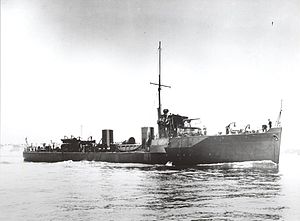River-class destroyer

HMS Eden, a River-class destroyer
|
|
| Class overview | |
|---|---|
| Name: | River- or E-class destroyer |
| Operators: |
|
| Preceded by: | D class |
| Succeeded by: | Tribal class |
| Built: | 1903–1905 |
| In commission: | 1903–1920 |
| Completed: | 36 |
| Lost: | 8 |
| General characteristics | |
| Displacement: | 535 long tons (544 t) to 570 long tons (580 t) |
| Length: | 221 ft (67 m) to 233 ft (71 m) (overall) |
| Beam: | 23 ft 6 in (7.16 m) to 23 ft 10.5 in (7.277 m) |
| Draught: | 7 ft 1 in (2.16 m)to 8 ft 0.5 in (2.451 m) |
| Propulsion: |
|
| Speed: | 25.5 knots (29.3 mph; 47.2 km/h) |
| Range: | 1,620 nmi (3,000 km) to 1,870 nmi (3,460 km) at 11 kn, except Stour and Test, 3,000 nmi (5,556 km) at 13 kn. |
| Complement: | 70 |
| Armament: |
|
The River-class destroyer (re-designated in 1913 as the E-class) was a class of torpedo boat destroyer built for the Royal Navy at the turn of the 20th century, and which saw extensive service in World War I. The class introduced new features to destroyer design, placing a greater emphasis on seakeeping and endurance and less on a high maximum speed in good weather. All the ships were named after British and Irish rivers, and as such were the first Royal Navy destroyer class to be named systematically.
The concept for the River class began in December 1900, with a request from John de Robeck, then the senior destroyer officer in the Mediterranean Fleet, for a new class of destroyer with a longer range than the existing "30-knotter" and "27-knotter" types. Robeck's specification called for a range of 1650 nm at a sustained speed of 18 knots; the "30-knotter" could only make 1400 nm at its cruising speed of 13 knots.
Robeck also called for various modifications to destroyer design to help ships make more seaworthy, in particular keeping up their speed in adverse weather conditions. The most noticeable change would be to introduce a raised forecastle rather than an arched turtleback for the hull forward of the bridge, and that the bridge should be placed further aft to keep it clear of spray from waves breaking over the bow. Furthermore, he felt that destroyers should run their speed trials with a more realistic load of fuel and supplies. The "30-knotter" type might have a nominal speed of 30 knots, but even in very good weather this was never achieved in service.
Other officers serving on Royal Navy destroyers made similar observations about their ships. Robeck's commanding officer, Admiral "Jackie" Fisher, drew a comparison with the German S90-class torpedo boat, which had impressed Royal Navy officers who had seen it.
...
Wikipedia
